
 |
|
|
|
#1 |
|
Endangered Dragon
 Join Date: Mar 2007
Posts: 8,566
|
Hey guys, i did a search on af and found several hermit keepers few years ago, i wonder anyone still keeping them? i kept them 5 years ago before i joined fish keeping.. quited mainly because of fish. 2 weeks ago, i was at c328 looking for interesting fish i could keep in my small spare tank and i chance upon a tub with some tiny hermit crabs. they were so cute i couldn't resist them.
Thought that it will be good i create a thread to share and at the same time, provide this thread as a guide to keeping them too... Today i was revamping their tank so took all 6 out and place them in a small pet container. you can see how small and cute they are.. the biggest guy is only about 1 - 1.5 inches long. 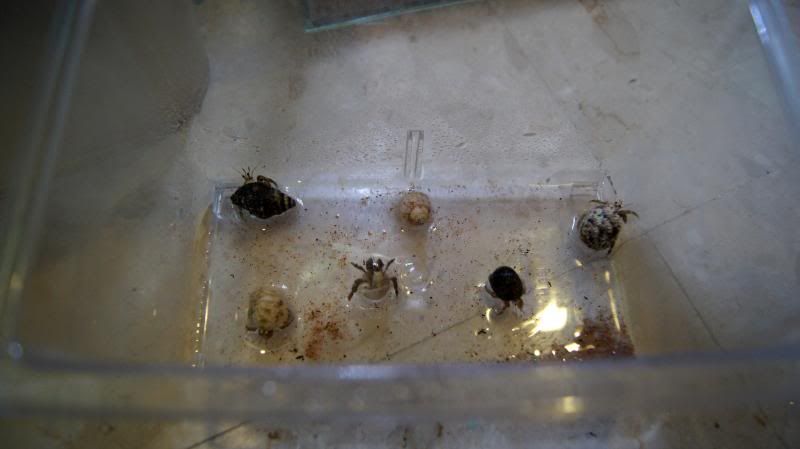 The biggest and my favorite guy, he's the most active in the tank and least afraid of me. 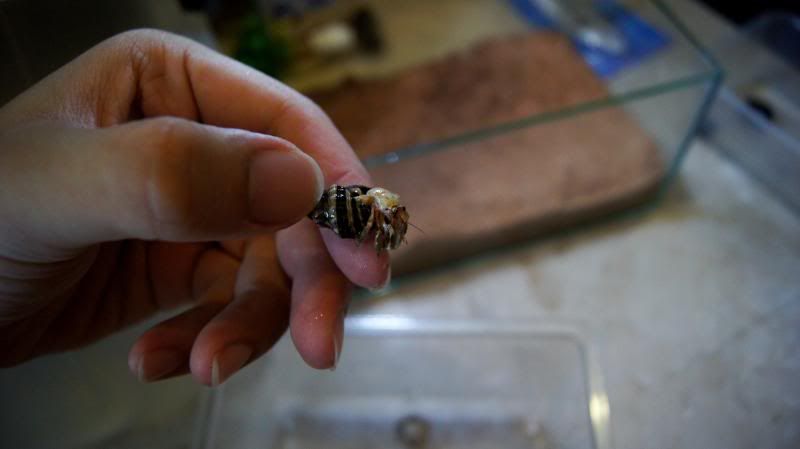 Now for a simple guide, you need a hermit crabitat that is either made of glass or acrylic.. a very fine sand that is at least 3 times taller than the ur largest crab is needed. for me, i use SUDO bottom sand and its proven to be a working sand as all 6 crabs molted during the first week i had them. calcium sand or gravels are not to be used. 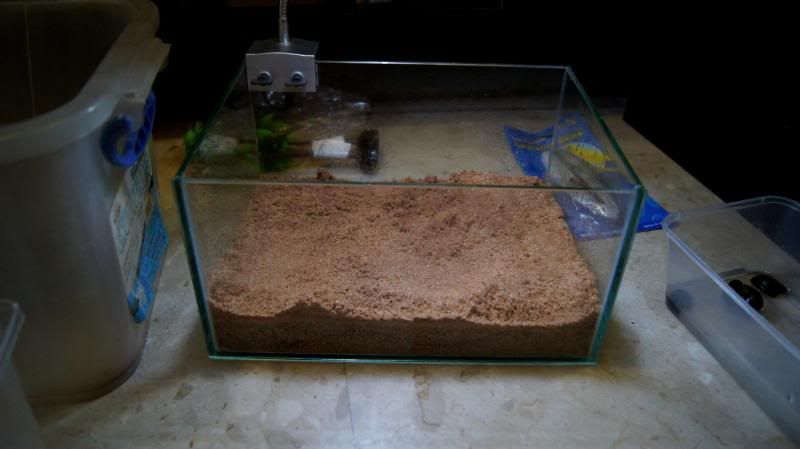 Next, Hermit crab need both fresh water and salt water.. freshwater need to be treated with seachem prime or similar dechlorinator to remove harmful substance just like what you'll do for your fish tank. Salt water refer to marine saltwater and not aquarium salt water.. i buy my marine saltwater from y934 (aquastar) since they do sell marine saltwater. your water dishes need to be deep enough for your largest crab to be able to fully submerge in it. pebbles or similar objects is required for your smaller crabs to climb out in case if it drops inside accidentally. 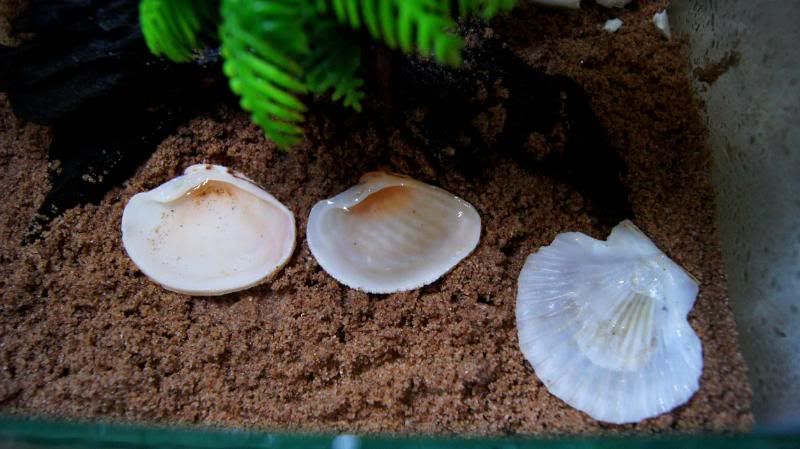 Calcium is an important source of nutrients your crabs need. i use cuttlefish bone broken into smaller bits scattered in the tank. 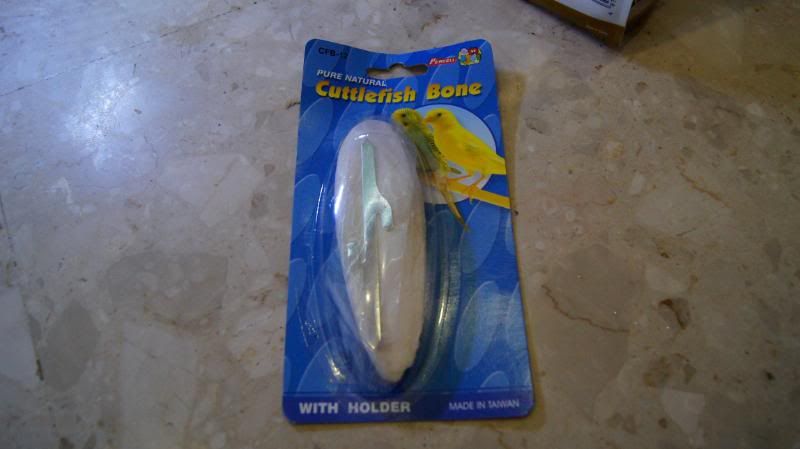 Hermit crabs love to climb so it is important that you have things like wood or toys(non-painted) for them to climb around.. for my tank, i have 2 wood and a fake coconut plant for them to climb around. they do eat shreds of wood too.  Completed tank 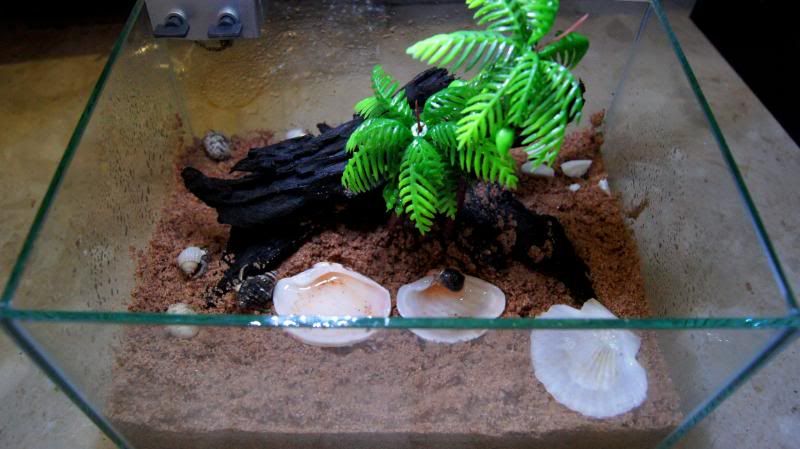
|
|
|

|
|
|
#2 |
|
Endangered Dragon
 Join Date: Mar 2007
Posts: 8,566
|
in goes the crabs!
 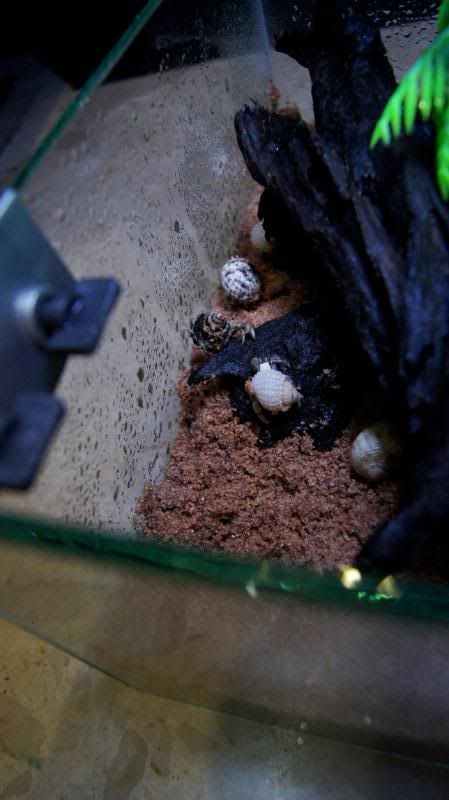 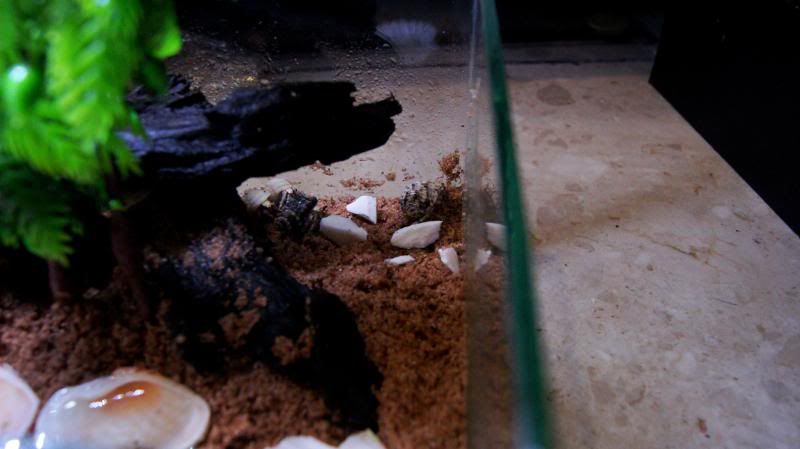 they dig to destress and molt. therefore it is important the correct substrate is used. 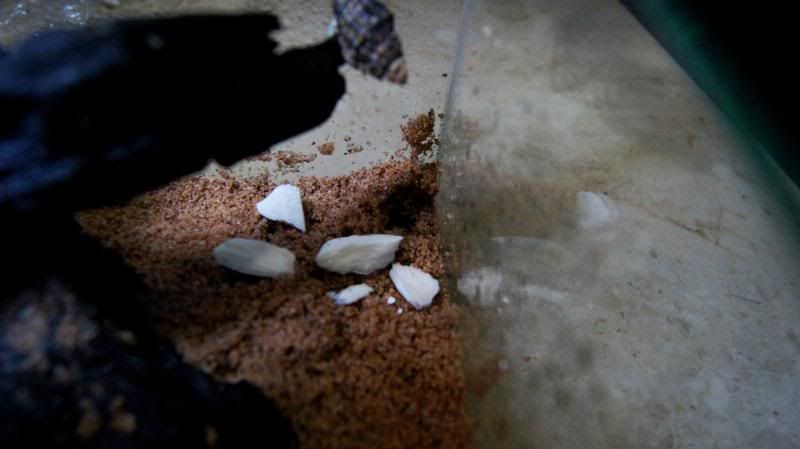 Please do search the net for more information as mine is just a simple guide.. please do add if i leave anything out! And please share your crabitat if you are still keeping them! |
|
|

|
|
|
#3 |
|
Endangered Dragon
 Join Date: Mar 2007
Posts: 8,566
|
As for food, they can eat a variety of fruits and meats cooked or raw, but certain food are not good for them. i found this list of safe and unsafe food from a hermit crab forum called hermit crab association.
a quote from HCA (do note that this list is not mine and all credit goes to the website) Safe food for hermits : Acorns (crush and soak overnight in salt water then drain before serving) Alfalfa Almonds, crushed Amaranth (Ancient grain) Anchovy oil Apple and natural, unsweetened apple sauce Apricot Arame Artichokes Asparagus Avocado Bamboo (live plants make wonderful tank toys and grazing) Banana Barley Beans, yellow wax Bell peppers (red, yellow, orange, green or purple) Bee pollen Beets Bilberries/Huckleberries Blackberry leaves Blackberry Blackstrap molasses (unsulfured) - amazingly high in nutrients such as calcium and potassium; 1-2 times monthly Bladderwrack Bloodworms (alive or dead) Blueberries Borage blossoms (Borago officinalis) Broccoli and leaves Brown rice Brussels sprouts Cabbage (all varieties) Calcium carbonate powder, plain Calendula flowers (Calendula officinalis)-Also known as "pot marigolds" Camellia (Camellia japonica) Canteloupe Carnation flowers (Dianthus caryophyllus) Carrots Carrot tops Cauliflower and leaves Celery leaves Cereal; Brown rice, soy, wheat or 7 grain, muesli Chamomile flowers Chard Cheese (be sure to get all natural varieties, serve as occasional treat) Cherimoya Cherry Chestnuts Chicken bones Chicken, cooked and unseasoned (smash the bone for marrow access) Chickweed Cholla wood Cilantro Citrus (all fruits) Clams Clover blossoms and leaves Coconut and coconut oil Cod liver oil Collards Cork bark Corn (on the cob, too) Cornmeal Cranberries (dehydrated) Crickets Crustaceans (any and all crustacea including crayfish, lobster, shrimp and other crabs) Cucumber Currants Cuttlefish bone, powdered Dairy products (milk, cheese, live-culture yogurt) ** Daisies (Bellis perennis) Dandelion flowers, leaves and roots (Taraxacum officinale) Day lilies (Hemerocallis) Egg, scrambled or soft boiled Eggplant Eggshells Elderberry flowers (Sambucus canadensis) Extra-virgin olive oil Fig (ripe fruit only) Fish flakes w/out chemical preservatives Fish Oil Flax seeds/Linseeds (crushed) Flax seed oil (small amounts infrequently) Frozen fish food (esp. algae, krill and brine shrimp) Garbanzos Gladiolus (Gladiolus spp.) Gooseberry (ripe or overripe) Grape Leaf Grapes Grapevine (vines and root) Green and red leaf lettuce (not iceburg; dark green) Green Beans Hazel leaves Hempseed Meal Hibiscus flowers (Hibiscus rosa-sinensis) Hikari products: brine shrimp, krill, crab cuisine, sea plankton (no preservatives) Hollyhock flowers Honey (organic, or at least locally produced, for anti-microbials) Honeybush Honeydew Melon Honeysuckle flowers (Japanese Lonicera japonica) Impatiens (Impatiens wallerana) Irish Moss Japanese red maple leaves, dried (Acer palmatum) Jasmine flowers (Jasmine officinale) Johnny-Jump-Up flowers--(Viola tricolor) Kamut Kelp Kiwi Lentils Lilac (Syringa vulgaris) Lima Beans Lobster with crushed exoskeleton Locusts (dead) Lychee fruit (fresh; no kernel) Macadamia nuts Madrona wood Mango Mangrove (small live trees can be obtained on eBay, use in water basin) Maple leaves Maple syrup Marion Berries Milk thistle flowers (Silybum marianum) Mint (but not peppermint!) Most organic baby foods Muscadine (grapes) Mushrooms Mussels Nasturtium flowers (Tropaeolum majus) Nettle (wilted) Nettle, stinging (pour boiling water over leaves first) Oak Leaves and bark Octopus Okra Olive and olive oil (extra virgin) Oranges Oysters Pansy flowers and leaves (Viola X Wittrockiana) Papaya Parsley Parsnip Passionflowers (Passifloraceae - passion flower family) Passionfruit Peaches Peanut butter (avoid sugar, corn syrup and hydrogenated oils) Peanuts Pears Peas Pecans Pecan bark Persimmon Petunia blossoms Pineapple Pistachio nuts Plum Pomegranate Popcorn (unseasoned, unflavored, unbuttered) Potato (no green parts, including eyes) Psyllium & husks Pumpkin Purslane (Portulaca oleracea) Quinoa (New World grain) Raisins (no sulphur dioxide) Raspberry Red raspberry leaves (highest bioavailable calcium source + vit. C and trace minerals) Rolled Oats Rooibus (or rooibos) Roquette (Eruca vesicaria) Rose petals (Rosa spp) Rose hips Royal Jelly Russian Olive leaves (Elaeagnus angustifolia) Sage blossoms (Salvia officinalis) Salmon Sand dollars Sardines Scallops Sea biscuits Sea fan (red or black) Sea grasses Sea salt Sea Sponges Semolina Sesame seeds (crushed) Sesame oil (in tiny amounts as appetite stimulant) Shrimp and exoskeletons Snails (use human food grade only; not wild snails) Sorrel (Rumex acetosa) Soy and soy products (human grade; miso, tofu, etc.) Spelt Spinach Spirulina (complete protein and chlorophyll source; highest in beta carotene) Sprouts (flax, wheat, bean, alfalfa, etc.) Squid Squash (and squash blossom) Star fruit (carambola) Strawberry and tops Sugar cane Sunflower Seeds (crushed), flowers and leaves (Helianthus) Swamp cypress wood (false cypress, taxodium sp.) Sweet potato Sycamore leaf Tahini (no garlic variety) Tamarillo Tangerine Timothy hay Tomato Tree Fern Triticale Tulip flowers (Tulipa spp.) Tuna Turnip greens Viola flowers Violet flowers (Viola odorata) Walnuts Wasa All-Natural Crispbread (Oat flavor) Watercress Watermelon Wheat grass Wheat Wheat germ Whitefish Whole Wheat Couscous Wild rice Zucchini (and zucchini flowers)* *This food list is mainly adapted from Summer Michealson and Stacey Arenella's book, The All-Natural Hermit Crab Sourcebook, and expanded on by Julia Crab and others ** After extensive tests in several EH member tanks, it has been discovered that dairy items are not lethal to crabs. In fact, most crabs really enjoy cheddar cheese, live-culture yogurt, and the occasional drink of milk. While extended long-term testing is still underway, there has been 8 months of trials with no harm to the test crabs. For now, dairy is acceptable, once every 30 to 60 days as a treat. It should not be relied upon as a food base. Unsafe food for hermits : While it is true that crabs are scavengers with a wide repertoire of foods they can eat, there are many plants and foods that just should not be fed to a crab. The foods on this list are to be avoided. Some are toxic, some are insect repellents or used as insecticides, and some the crabs just won't go near, such as lemon -- lemon won't hurt them, but they certainly won't eat it. This list, like the Edible List, will be updated regularly, so be sure to check back often. Aconite (Monk's Hood) African violet leaves African daisy (Osteospermum) Alder bark Aloe vera (interferes with potassium absorption) Amaryllis American Hellebore Anemone/Windflower Aniseed Avocado leaves Azalea/Rhododendron Bay leaves (natural insect repellent) Bindweed Bird of Paradise Flowers Bluebonnet Bottlebrush flowers Bougainvillea Boxwood Buckthorn Buttercup Carnation leaves Castor Bean Catnip Cherimoya Seeds Chocolate/cocoa Chrysanthemum Cinnamon Citrus (leaves and branches to be avoided; part of the evergreen family. The fruit is fine) Columbine Compost (unless 100% organic) Crocus Crown of Thorns Cube Plant Custard Apple (young fruit) Cyclamen Delphinium Derris Dieffenbachia Dill Dittany Eucalyptus European pennyroyal Evergreen (pine, cedar, juniper, etc.) Feverfew Fleabane Garlic Geranium Golden Pothos Green hellebore Hemlock Holly Berries Horsetail Ivy (of any kind) Juniper Berries Kalanchoe Larkspur seed Laurel Lavender Lemon Balm (Sweet Melissa) Lemon Grass Lucky Bamboo (Dracaena sanderiana) Mayweed Mistletoe Morning Glory Mulberry leaves Oleander Onion Oxeye daisy Papaya seed Parsley Seed (fruit) Peace Lily Pencil Tree Cactus Peppermint Philodendron Pine or cedar wood or needles Prickly juniper Pride of China fruit Prunus species trees (apricot, bitter almond, cherry, cherry laurel, nectarine, peach, plum) Fleshy fruits are edible, everything else contains a cyanide-like compound and is fatally toxic, including seeds, wood, leaves, bark and flowers. Red Emerald Rosemary Sago Palm Sanseveria Schefflera Stargazer Lily (Lilium x Stargazer) Sweet Flag Tansy Tea Tree Texas Mountain Laurel (Sophora secundiflora) Thornapple Thyme Tobacco Vanillin Verbena Vinca Wild Angelica fruit Wormwood Yew Yarrow Taken from : http://www.hermitcrabassociation.com...p?f=25&t=64004 http://www.hermitcrabassociation.com...p?f=25&t=64005 *mod please remove the link if its not allowed thanks* |
|
|

|
|
|
#4 |
|
Dragon
     Join Date: Jan 2012
Posts: 809
|
Thanx for the information bro!
Intending to keep some Hermit Crabs as well. Btw, do they die easily? And do they bite? Hermit Crabs will hop around different shells right? |
|
|

|
|
|
#5 | |
|
Endangered Dragon
 Join Date: Mar 2007
Posts: 8,566
|
Quote:
Hermit crab changes shells as they grow bigger so providing them with more shells for them to choose is good. i bought packs of shell from y934 and saw them in polyart too. i bought snails from c328 and use their shell in hope that those crabbies will use them. its hard to find such small sea shells for them. |
|
|
|

|
|
|
#6 |
|
Senior Dragon
 Join Date: May 2003
Posts: 4,395
|
i saw a tank full of hermit crabs at rainbow farm. all looking active.

|
|
|

|
|
|
#7 |
|
Endangered Dragon
 Join Date: Mar 2007
Posts: 8,566
|
Here's my tank FTS. its a 25x18x13cm tall tank. a pretty small tank but big enough for the 6 small crabs currently. i do intend to upgrade to a 45x25x25cm tank soon for more roaming area and probably a 2nd layer. i noticed Pets lover centre do sell some hermit crab accessories like water tray and thats wherei bought my coconut tree.
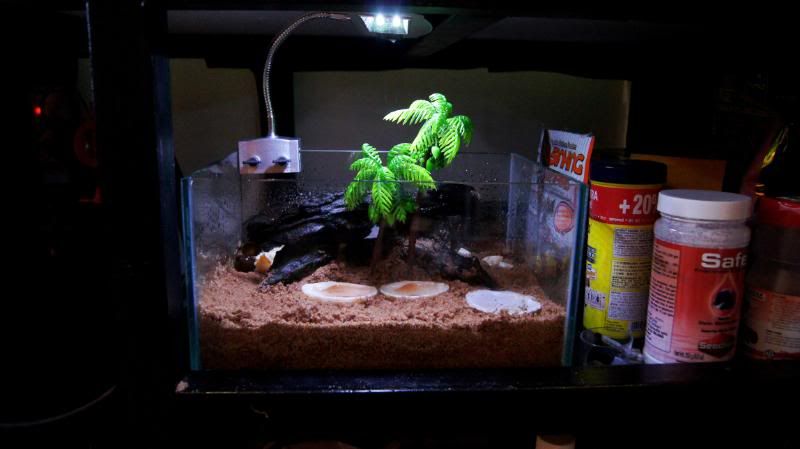 See how much they love to climb! to the top of the coconut tree! 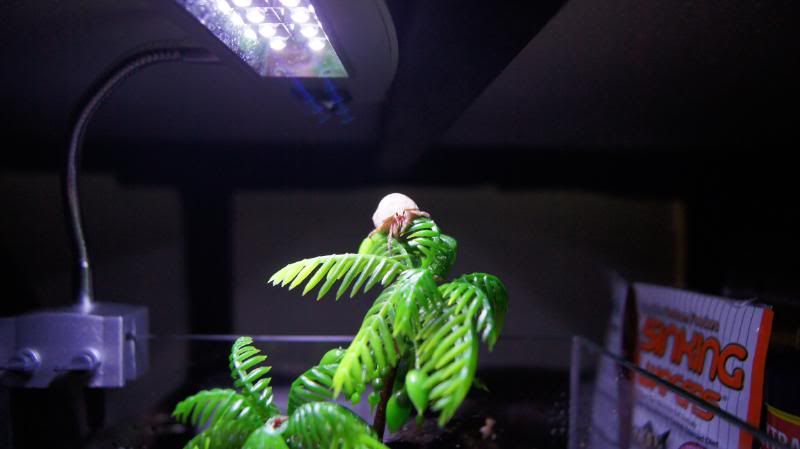 They can even hang upside down and crawl. 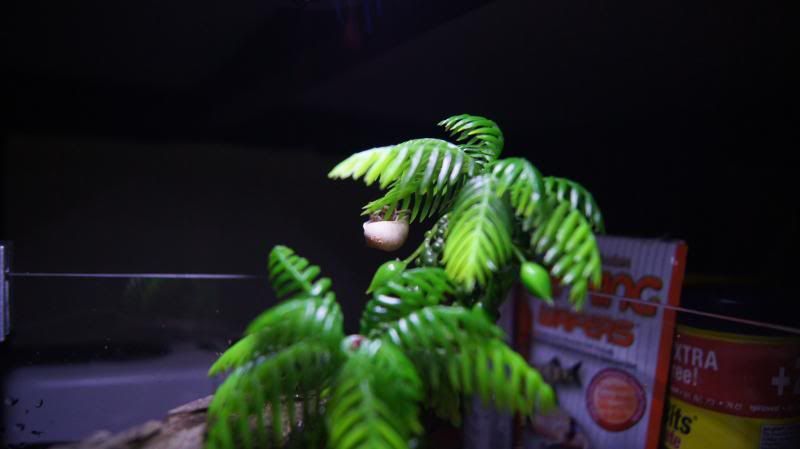 Do make sure either u provide a secured cover to prevent escapees or make sure there is no way the crabs can escape out from your tank. |
|
|

|
|
|
#8 | |
|
Endangered Dragon
 Join Date: Mar 2007
Posts: 8,566
|
Quote:
Athough they are nocturnal animals, they are actually pretty active throughout the day. they enjoy companion and often travel is very large groups in the wild. i would suggest at least 3 should be kept together. the more the better provided your tank is large enough. |
|
|
|

|
|
|
#9 | |
|
Dragon
     Join Date: Jan 2012
Posts: 809
|
Quote:
And you mentioned need to put both fresh and salt water for the Hermit Crabs, is that a must? Cannot just put fresh water? I can just buy marine salt to mix with water instead of buying salt water from LFS? Thanx for all the clarification. 
|
|
|
|

|
|
|
#10 |
|
Senior Dragon
 Join Date: May 2003
Posts: 4,395
|
about the same size as yours,if i recall correctly.
|
|
|

|
 |
|
| Currently Active Users Viewing This Thread: 1 (0 members and 1 guests) | |
|
|